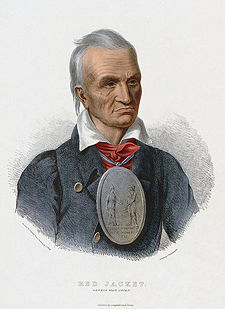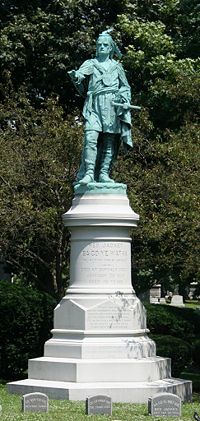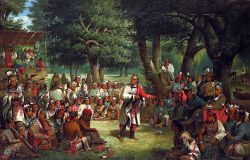Difference between revisions of "Red Jacket" - New World Encyclopedia
Mary Anglin (talk | contribs) |
Mary Anglin (talk | contribs) m |
||
| Line 1: | Line 1: | ||
{{Images OK}} | {{Images OK}} | ||
| − | [[Image:Red Jacket 2.jpg|right| | + | [[Image:Red Jacket 2.jpg|right|225px|thumb|Red Jacket from an 1835 [[lithograph]] based upon a painting by C. Hallmandel.]] |
| − | '''Red Jacket''' (known as '''Otetiani''' in his youth and '''Sagoyewatha''' after 1780) (c. 1750–[[January 20]], [[1830]]) was a [[Native Americans in the United States|Native American]] [[Seneca tribe|Seneca]] orator and chief of the Wolf clan | + | '''Red Jacket''' (known as '''Otetiani''' in his youth and '''Sagoyewatha''' after 1780) (c. 1750–[[January 20]], [[1830]]) was a [[Native Americans in the United States|Native American]] [[Seneca tribe|Seneca]] orator and chief of the Wolf clan. |
==Life== | ==Life== | ||
| − | + | [[Image:Red Jacket monument.jpg|thumb|200px|Monument at Forest Lawn Cemetery]] | |
| + | Otetiani was born near present day [[Geneva, New York]] and lived much of his life in Seneca territory in the [[Genesee River]] Valley. Although they often met together at the Long House, he and [[Mohawk nation|Mohawk]] chief [[Joseph Brant]] were bitter enemies and rivals. Brant contemptuously referred to Red Jacket as "cow killer" alleging that at the [[Battle of Newtown]] in 1779 Red Jacket killed a cow and then used the blood to claim he had killed an American.<ref>Graymont, pg. 216</ref> | ||
| − | In 1794, Red Jacket was a signatory along with [[Cornplanter]] and fifty other [[Iroquois]], of the [[Treaty of Canandaigua]] | + | In 1794, Red Jacket was a signatory along with [[Cornplanter]] and fifty other [[Iroquois]], of the [[Treaty of Canandaigua]] confirming peace with the United States and the earlier boundaries of 1788 [[the Phelps and Gorham Purchase]] of most of the Seneca land east of the [[Genesee River]] in western New York. In 1797, [[Robert Morris (merchant)|Robert Morris]] then purchased rights to some lands west of Genesee River from the Senecas for $100,000 by the Treaty of Big Tree (now [[Geneseo (village), New York|Geneseo, New York]] in present [[Livingston County, New York|Livingston County]]). He originally tried to prevent the sale, but was not able to convince the others, and gave up his opposition. The sale was well "greased" by a great deal of [[liquor]] and [[Bribery|bribes]] of trinkets to the Iroquois women. Morris, who had previously purchased the land from Massachusetts, subject to the Indian title, then sold it to the [[Holland Land Company]], retaining only [[the Morris Reserve]], an estate near present day [[Rochester, Monroe County, New York|Rochester]]. |
| − | |||
Red Jacket took this name, one of several, for a highly favored embroidered coat given to him by the British for his wartime services. The Senecas took the British side during the [[American Revolution]], a costly mistake, since their ally ultimately lost. In the [[War of 1812]], Red Jacket supported the American side. In 1792, George Washington presented Red Jacket with the sterling silver peace medal shown in the illustration at right. That medal, and the John Mix Stanley painting shown below, survive today in the collection of the [[Buffalo and Erie County Historical Society Building | Buffalo and Erie County Historical Society]]. | Red Jacket took this name, one of several, for a highly favored embroidered coat given to him by the British for his wartime services. The Senecas took the British side during the [[American Revolution]], a costly mistake, since their ally ultimately lost. In the [[War of 1812]], Red Jacket supported the American side. In 1792, George Washington presented Red Jacket with the sterling silver peace medal shown in the illustration at right. That medal, and the John Mix Stanley painting shown below, survive today in the collection of the [[Buffalo and Erie County Historical Society Building | Buffalo and Erie County Historical Society]]. | ||
| − | Red Jacket was also known for his oratory skill. His alternative name, Segoyewatha, roughly translates ''he keeps them awake''. He is best known for his response to a New England [[missionary]] (a Mr. Cram) who had requested in 1805 to do mission work among the Senecas. | + | Red Jacket was also known for his oratory skill. His alternative name, Segoyewatha, roughly translates ''he keeps them awake''. He is best known for his response to a New England [[missionary]] (a Mr. Cram) who had requested in 1805 to do mission work among the Senecas. Red Jacket's famous speech, as an [[apologist]] for the Native American [[religion]], was called [http://www.bartleby.com/268/8/3.html#txt1 Red Jacket on Religion for the White Man and the Red]. |
Red Jacket had a problem with [[Alcoholism|alcohol]] and deeply regretted his first drink. Once a lady asked him if he had any children. Red Jacket, who had lost most of his children to illness, replied sorrowfully: | Red Jacket had a problem with [[Alcoholism|alcohol]] and deeply regretted his first drink. Once a lady asked him if he had any children. Red Jacket, who had lost most of his children to illness, replied sorrowfully: | ||
| Line 22: | Line 22: | ||
==Legacy== | ==Legacy== | ||
| − | [[Image:The Trial of Red Jacket.jpg|thumb| | + | [[Image:The Trial of Red Jacket.jpg|thumb|250px|The Trial of Red Jacket, by [[John Mix Stanley]], 1869]] |
* A complex of dormitory buildings at the [[University at Buffalo, The State University of New York|University at Buffalo]] is named after him. | * A complex of dormitory buildings at the [[University at Buffalo, The State University of New York|University at Buffalo]] is named after him. | ||
* Red Jacket Dining Hall at [[SUNY Geneseo]] is named after him. | * Red Jacket Dining Hall at [[SUNY Geneseo]] is named after him. | ||
| Line 42: | Line 42: | ||
* Koch, Robert G. 1992. [http://crookedlakereview.com/articles/34_66/48mar1992/48koch.html Red Jacket: Seneca Orator] ''Crooked Lake Review''. Retrieved February 3, 2009. | * Koch, Robert G. 1992. [http://crookedlakereview.com/articles/34_66/48mar1992/48koch.html Red Jacket: Seneca Orator] ''Crooked Lake Review''. Retrieved February 3, 2009. | ||
* Red Jacket. 1805. [http://www.bartleby.com/268/8/3.html Red Jacket on Religion for the White Man and Red] ''Bartleby Books Online''. Retrieved February 3, 2009. | * Red Jacket. 1805. [http://www.bartleby.com/268/8/3.html Red Jacket on Religion for the White Man and Red] ''Bartleby Books Online''. Retrieved February 3, 2009. | ||
| + | *Maine League of Historical Societies and Museums, and Dorris A. Isaacson. 1970. ''Maine, a guide "down east."''. American guide series. Rockland, Me: Courier-Gazette. {{OCLC|143588}} | ||
* Wallace, Anthony F. C. 1972. ''The death and rebirth of the Seneca.'' Vintage books, 699. New York, NY: Random House. ISBN 039471699X | * Wallace, Anthony F. C. 1972. ''The death and rebirth of the Seneca.'' Vintage books, 699. New York, NY: Random House. ISBN 039471699X | ||
Revision as of 03:14, 4 February 2009
Red Jacket (known as Otetiani in his youth and Sagoyewatha after 1780) (c. 1750–January 20, 1830) was a Native American Seneca orator and chief of the Wolf clan.
Life
Otetiani was born near present day Geneva, New York and lived much of his life in Seneca territory in the Genesee River Valley. Although they often met together at the Long House, he and Mohawk chief Joseph Brant were bitter enemies and rivals. Brant contemptuously referred to Red Jacket as "cow killer" alleging that at the Battle of Newtown in 1779 Red Jacket killed a cow and then used the blood to claim he had killed an American.[1]
In 1794, Red Jacket was a signatory along with Cornplanter and fifty other Iroquois, of the Treaty of Canandaigua confirming peace with the United States and the earlier boundaries of 1788 the Phelps and Gorham Purchase of most of the Seneca land east of the Genesee River in western New York. In 1797, Robert Morris then purchased rights to some lands west of Genesee River from the Senecas for $100,000 by the Treaty of Big Tree (now Geneseo, New York in present Livingston County). He originally tried to prevent the sale, but was not able to convince the others, and gave up his opposition. The sale was well "greased" by a great deal of liquor and bribes of trinkets to the Iroquois women. Morris, who had previously purchased the land from Massachusetts, subject to the Indian title, then sold it to the Holland Land Company, retaining only the Morris Reserve, an estate near present day Rochester.
Red Jacket took this name, one of several, for a highly favored embroidered coat given to him by the British for his wartime services. The Senecas took the British side during the American Revolution, a costly mistake, since their ally ultimately lost. In the War of 1812, Red Jacket supported the American side. In 1792, George Washington presented Red Jacket with the sterling silver peace medal shown in the illustration at right. That medal, and the John Mix Stanley painting shown below, survive today in the collection of the Buffalo and Erie County Historical Society.
Red Jacket was also known for his oratory skill. His alternative name, Segoyewatha, roughly translates he keeps them awake. He is best known for his response to a New England missionary (a Mr. Cram) who had requested in 1805 to do mission work among the Senecas. Red Jacket's famous speech, as an apologist for the Native American religion, was called Red Jacket on Religion for the White Man and the Red.
Red Jacket had a problem with alcohol and deeply regretted his first drink. Once a lady asked him if he had any children. Red Jacket, who had lost most of his children to illness, replied sorrowfully:
- Red Jacket was once a great man, and in favor with the Great Spirit. He was a lofty pine among the smaller trees of the forest. But, after years of glory, he degraded himself by drinking the firewater of the white man. The Great Spirit has looked upon him in anger, and his lightning has stripped the pine of its branches.
In his later years, he lived in Buffalo, New York. Red Jacket's grave and a monument to his honor are in Forest Lawn Cemetery. He was initially buried in a Native American cemetery but his remains were dug up and reinterred at Forest Lawn despite his specific instructions that no white man dig up and rebury him.
On the Religion of the White Man
A speech he gave to a Christian missionary. In it, Red Jacket refers to God as "the great spirit" as he replies and identifies to the great spirit simultaneously as the Christian God. He poses a series of questions about the validity of the Bible and argues that the Great Spirit has different designs for his white children and for his red children when it comes to the practice of religion.
Legacy
- A complex of dormitory buildings at the University at Buffalo is named after him.
- Red Jacket Dining Hall at SUNY Geneseo is named after him.
- The Red Jacket clipper ship that set the unbroken speed record from New York to Liverpool is named after him.[2]
- A public school system, Red Jacket Central, also is named in honor of Segoyewatha and serves the communities of Manchester and Shortsville in Ontario County, New York.
- A section of the Buffalo River (New York) is named "Red Jacket Peninsula" in his honor. An informational plaque anointing the aforementioned, with a brief Red Jacket bio as well as other river history, is located along the eastern bank of the river (close to the mouth) at a New York State Department of Environmental Conservation access park, located at the southwestern end of Smith Street in Buffalo, New York.
- The community of Red Jacket in southern West Virginia was named for him, though he is not known to have had any personal connection to that region.[3]
- Red Jacket also has a memorial statue in Red Jacket Park in Penn Yan, New York. The statue was sculpted by Michael Soles.
Notes
- ↑ Graymont, pg. 216
- ↑ Maine League of Historical Societies and Museums (1970). in Doris A. Isaacson: Maine: A Guide 'Down East'. Rockland, Me: Courier-Gazette, Inc., 260–261.
- ↑ Kenny, Hamill (1945). West Virginia Place Names: Their Origin and Meaning, Including the Nomenclature of the Streams and Mountains. Piedmont, West Virginia: The Place Name Press, 524.
ReferencesISBN links support NWE through referral fees
- Graymont, Barbara. 1972. The Iroquois in the American Revolution. A New York State study. [Syracuse, N.Y.]: Syracuse University Press. ISBN 0815600836
- Koch, Robert G. 1992. Red Jacket: Seneca Orator Crooked Lake Review. Retrieved February 3, 2009.
- Red Jacket. 1805. Red Jacket on Religion for the White Man and Red Bartleby Books Online. Retrieved February 3, 2009.
- Maine League of Historical Societies and Museums, and Dorris A. Isaacson. 1970. Maine, a guide "down east.". American guide series. Rockland, Me: Courier-Gazette. OCLC 143588
- Wallace, Anthony F. C. 1972. The death and rebirth of the Seneca. Vintage books, 699. New York, NY: Random House. ISBN 039471699X
External links
All Links Retrieved February 3, 2009.
- An Account of Sa-Go-Ye-Wat-Ha, or Red Jacket, and His People, available for free via Project Gutenberg by John Niles Hubbard
- Red Jacket at Find A Grave
Credits
New World Encyclopedia writers and editors rewrote and completed the Wikipedia article in accordance with New World Encyclopedia standards. This article abides by terms of the Creative Commons CC-by-sa 3.0 License (CC-by-sa), which may be used and disseminated with proper attribution. Credit is due under the terms of this license that can reference both the New World Encyclopedia contributors and the selfless volunteer contributors of the Wikimedia Foundation. To cite this article click here for a list of acceptable citing formats.The history of earlier contributions by wikipedians is accessible to researchers here:
The history of this article since it was imported to New World Encyclopedia:
Note: Some restrictions may apply to use of individual images which are separately licensed.


